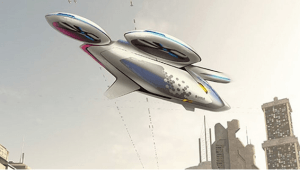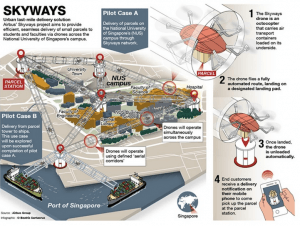
Congestion in cities is at an all-time high, and there seems to be no respite in sight for exasperated motorists. One solution, aside from getting on board a packed train, is to avoid the chaos by taking to the skies. Personal flying cars remain something of a pipe dream, but Airbus belives autonomous commuter aircraft could be a solution to our congestion woes. What’s more, the company is actively working to make it happen within the next decade.
Airbus isn’t the first company to dip its toe into the aerial commuting waters. Joby is working on a 16-rotor commuter aircraft, Ehang has been cleared to test its 184 taxi drone in Nevada and Volocopter made its first manned flight in April this year. The idea of hopping into a multi-rotor autonomous taxi and flying to work might seem a bit Jetsons now, but there are plenty of people out there working to make it happen.
Details about the electric multi-rotor being developed at Airbus’ Silicon Valley-based innovation outpost, A3, through the Vahana project are currently still under wraps. Even so, Airbus Project Executive Rodin Lyasoff says “many of the technologies needed, such as batteries, motors and avionics are most of the way there.”
Although the hardware is almost ready, the main thing slowing project Vahana down is sense-and-avoid technology. Reliable systems are only just finding their way into cars, and Lyasoff says making them work in autonomous aircraft is “one of the bigger challenges [the team] aims to resolve as early as possible.”
 Exciting as it is, Vahana is still in its infancy. Work started in February this year, with flight testing set to start at the end of 2017. In spite of its relative youth, Airbus is optimistic about when commuters will be able to hop on a drone for their morning commute.
Exciting as it is, Vahana is still in its infancy. Work started in February this year, with flight testing set to start at the end of 2017. In spite of its relative youth, Airbus is optimistic about when commuters will be able to hop on a drone for their morning commute.
“We believe that global demand for this category of aircraft can support fleets of millions of vehicles worldwide,” Lyasoff says. “In as little as 10 years, we could have products on the market that revolutionize urban travel for millions of people.”
In addition to the Vahana project, Airbus also has teams based in Germany and France developing a helicopter-style “CityAirbus” to carry multiple passengers. The futuristic design – rendered in the hero image at the top of this article – would initially be operated by pilots, before transitioning to autonomous control when regulations catch up.
Unlike Vahana, CityAirbus is aimed at taking multiple passengers at once, in an attempt to keep passenger costs down. Lessons learned in the multi-passenger craft’s development will be passed on to Vahana and Skyway, which is a drone-delivery trial set to take place in Singapore next year.
So, how would all of this work in an ideal world? Well, the zenAIRCITY concept dreamt up by Vassilis Agourdas and Benjamin Struss at Airbus Helicopters imagines travellers ordering a ride on their zenHOP app, choosing a zenHUB in the city to land on while their bags are whisked to the zenHUB using the zenLUGGAGE system. Watching over things is zenCYBER, which will make sure the ride isn’t ruined by hackers. (In case you’re wondering, the “zen” prefix stands for zero emissions and noise.)
It might be science fiction at the moment, but Airbus is convinced such visions will become a reality in the not too distant future.
“I’m no big fan of Star Wars, but it’s not crazy to imagine that one day our big cities will have flying cars making their way along roads in the sky,” says Airbus Group CEO Tom Enders. “In a not too distant future, we’ll use our smartphones to book a fully automated flying taxi that will land outside our front door – without any pilot.
